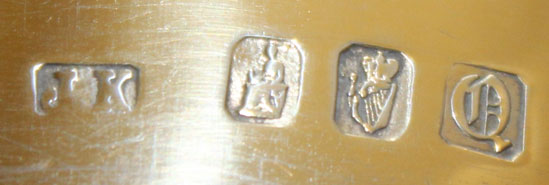Sir,—Oliver Doyle’s interesting ‘Artefacts’ contribution in the last issue (HI 31.4, July/August 2023, p. 35) revealed just how significant the Croagh Patrick pilgrimage has been, and is to this day, adding the significant aspect of transport and how the railway company acknowledged its service, and no doubt profits, by the presentation of a chalice and ciborium. The description concerning the hallmarks on these pieces, however, needs a reappraisal.

(1) ‘Solid silver’ is a misnomer for sterling silver, as solid or 100% pure silver is not able to be used. Sterling silver is 92.5% pure, the rest necessary alloy. These pieces are sterling silver gilded.
(2) The Irish Assay was founded in 1637 and is the only authorised functioning Irish assay. Initially the sterling standard was the same as in the silver coinage, hence the term ‘pound sterling’.
(3) The crowned harp mark is not for Dublin but an expression of the sterling silver standard for Irish products, in the same way as the leopard passant is for English silver. Every silversmith must submit his or her work for assaying at the sterling standard and, when achieved, these marks are added. Assay marks are the guarantee of quality and manufacturer for the consumer.
(4) What the author describes as ‘Britannia’ is in fact the Hibernia mark, which was instigated as a duty mark in 1730 (6d. per ounce). It continued into modern times, and it is this mark which is associated as the Dublin mark, though as the only Irish assay it is not necessary. You can see it is Hibernia, as she has a harp by her side and resembles the Hibernia on Wood’s Ha’pence of the 1720s.
(5) The appellation of Britannia here is made more tricky, as there was a ‘Britannia’ higher standard for silver purity, introduced in 1690 for all assay offices (95.8% pure silver) and requiring different designs. Britannia standard is still used but expensive to produce, and most ware is sterling standard.
(6) The date letter is correct for 1911, but the date letters were not automatically changed on the new year at this time.
The assay marks on Irish and British silver present an accurate and historically delightful cluster of information on standard, place, date and manufacturer. Useful reference works include the regularly reprinted English silver hallmarks (includes Irish and Scottish), edited by Judith Banister; Sir Charles Jackson’s English goldsmiths and their marks (also includes Irish and Scottish); and Douglas Bennett’s Collecting Irish silver. There are other works dealing with Irish silver, as exhibition catalogues, museum guides etc.
While Dublin was and is the only functioning Irish assay office, silver products were made in other locations where manufacturers chose not to send plate to Dublin—either out of local pride or out of fear of loss from highway robbers—and to press for their own assay office, as was the case with Cork and Limerick silversmiths. Marks from these makers frequently stamped the word ‘sterling’ alongside their names or initials. Cork and Limerick silver is covered mainly in John R. Brown and Conor O’Brien’s Cork silver and gold: four centuries of craftsmanship and their A celebration of Limerick’s silver. Both of these works are handsomely illustrated with items and makers’ marks, and designations of location. There are examples of early silverware products from places such as Kilkenny, Youghal, Galway, Sligo—all very rare.
While Cork, Limerick and other locations failed to get their own assay offices by law, despite requests and pressure groups, one was granted by law but no wares were ever produced. In 1784 the Irish parliament passed an act (23 & 24 Geo III, cap. 23) for New Geneva, Co. Waterford, where an immigrant group of Swiss arrived, but soon left and returned. The buildings erected for them were converted into barracks during 1798.
Other, and periodic, marks do appear on assayed Irish silver: e.g. the monarch’s head for tax purposes 1807–90; a mark for joining the EEC in 1973; plus others. The date letter did not correspond exactly to the calendar year as we know it now. Once an alphabet sequence ended it was customary to renew the sequence with different-style letters and shield containers. With recent EU regulations the sterling standard as a number is required to be stamped, making redundant the crowned harp mark; and the date letter has now become optional with an additional cost to apply. However, manufacturers and retailers see a valuable provenance tool in continuing with the old marks. Hibernia and the crowned harp continue to designate Irish silver.—Yours etc.,
JOHN STOCKS POWELL
Co. Laois
